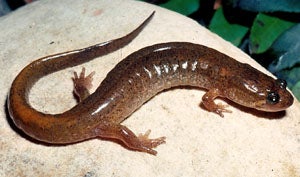SCIENTIFIC NAME:
Desmognathus conanti (Rossman)
OTHER NAMES:
Desmognthus fuscus conanti, Spring lizard
STATUS:
Fairly common to common statewide except where absent in extreme southern portion of Dougherty Plain and Southern Pine Plains and Hills. Alabama populations were formerly considered to be northern dusky salamander, D. fuscus. Some Coastal Plain populations may represent an undescribed species. Lowest Conservation Concern.
DESCRIPTION:
A moderate-sized, four-legged salamander averaging 1.2-2.4 inches in length, with individuals up to 5 inches in length described in the literature. The tail is moderately keeled.Individual populations (and even individuals within a single population) of Spotted Dusky Salamanders are remarkably variable with respect to markings and coloration, making a reliable description based on these characters nearly impossible. In most individuals, however, the back ranges from light tan to dark brown, with the belly typically cream-colored and variably marked with dark mottling. One of the most characteristic attributes of Spotted Dusky Salamanders is that coloration between the back and belly grade into one another gradually, versus the sharp transition seen in the Seal Salamander (Desmognathus monticola), a species with which the Spotted Dusky Salamander is often confused. Back markings are incredibly variable, ranging from no markings whatsoever to alternating pairs of six to seven spots that may be round, square, or irregular in shape. Coloration also varies with age, as older individuals are typically darker and less strongly patterned than younger ones. Larvae are characterized by an alternating pattern of six to seven pairs of spots running down the length of the back.
DISTRIBUTION:
Wide-ranging across the southern United States from Louisiana and Arkansas eastward to South Carolina. Found statewide in Alabama.
HABITAT:
Habitat types are almost as variable as coloration in this species but are always associated with water. Documented habitat types for the species include the edge of seeps, swamps, swales, small streams, and temporary pools in bottomland forest. Spotted Dusky Salamanders have also been found to use moist regions of sandstone cliffs in northwestern Alabama that are not directly associated with permanent water (Smith 2009). In all cases, Spotted Dusky Salamanders can be found under cover objects such as rocks, downed logs, and moss cover, often emerging from cover objects at night to forage.
LIFE HISTORY AND ECOLOGY:
According to studies of Alabama populations, mating in Spotted Dusky Salamanders is thought to occur from late summer through early fall. Eggs are laid in small depressions found within soil or under rocks and logs and are laid beginning in late July through October. Females attend their clutches of eggs once laid, which can number up to almost 40 individuals. Young hatch in 6-7 weeks, and larvae mature in 7 months to a year. As is the case with other Dusky Salamanders, sexual maturity is reached in Spotted Dusky Salamanders in 2 to 3 years. As local abundances can be high in and around the margins of some streams, Spotted Dusky Salamanders likely form an important ecological component of aquatic ecosystems by acting as predators of arthropods and other invertebrates and by serving as prey for insects (larvae), as well as snakes, birds, and small mammals (adults).
BASIS FOR STATUS CLASSIFICATION:
Although studies in the Atlanta, Georgia area have found Spotted Dusky Salamanders to be sensitive to the environmental effects of urbanization in some streams (Orser and Shure 1972), local populations have high abundances and are thought to be largely stable.
REFERENCES:
Orser, P.N. and D.J. Shure. 1972. Effects of urbanization on the salamander Desmognathus fuscus fuscus. Ecology.53:1148–1154.
Smith, W.H. 2009. Desmognathus conanti. Habitat. Herpetological Review. 40:66.
AUTHOR: Walter H. Smith – University of Alabama, Alabama Partners in Amphibian and Reptile Conservation






